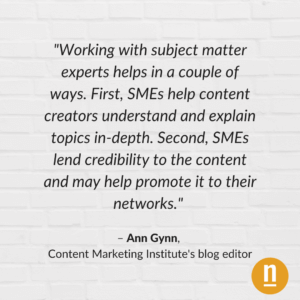It’s a fact that producing high-quality content is critical for your website, social media channels, email newsletters, and more. Creating the highest quality content has three benefits—it increases readership, lowers bounce rates, and results in higher conversions.
But how do you know if the content you’re creating is high-quality? Who determines if it is or isn’t? The short answer is—your readers.
Because your readers (or users) determine the quality of your content, it’s up to you to determine how to deliver the content they want—whether it’s for education or entertainment. This article discusses nine targeted solutions you need to create the best quality content.
Unlock These Targeted Tips for High-Quality Content
1: Get to Know Your Target Audience
Creating the highest quality content involves getting to know your target audience. Remember, you’re writing for your readers—not for yourself. You’ll need to conduct some research to complete this step, including researching your target audience and segmentation. Here are some basic steps for identifying your target audience:
- Identify the problems your products or services solve, why customers might choose your solutions, whether they need coaching to understand your offerings, and more
- Outline your target customer’s demographics, including geographic location, income, lifestyle, and more
- Define your ideal customer’s pain points to determine what motivates them to buy, concerns they might have regarding your offerings, how your products or services solve their problem, and more
- Learn where your audience spends their time online—websites they visit, blogs they read, social media platforms they belong to, search terms they use, and more
After completing this research, it’s time for audience segmentation. That involves identifying subgroups your target audience fits into according to their interests, behaviors, and other attributes. For example, our audience segments at nDash include:
- Company News: What’s new and exciting at nDash?
- For Agencies: Resources for agencies
- For Marketers: Resources for marketers
- For Writers: Resources for freelance writers
- Product Updates: New features and other valuable updates for writers and brands
- Success Stories: Hear what our current and past clients have to say about working with nDash
- Writer Spotlights: Great new writers on the nDash platform
2: Avoid Keyword Stuffing
Keyword stuffing is a form of black hat SEO that does nothing but harm your rankings. Black hat SEO refers to tactics users implement to increase rankings despite violating the search engine’s terms of service. So, the best practice for creating high-quality content is to avoid this tactic altogether—otherwise, you risk suffering from heavy penalties from the search engine.
You can avoid this happening by:
- Conducting in-depth keyword research
- Avoiding the use of incorrect phrases
- Increase word counts (cover your topic in as much detail as possible)
- Aim for optimal keyword density
- Add secondary and long-tail keywords
- Include your target keyword in page titles, tags, subheadings, alt tags, and meta descriptions
3: Craft Better Headlines and Titles
Headlines and titles provide windows of opportunities for writers (bands, companies, and more) to connect with their audience. Let’s dig into headline and title stats before anything else:
- Nearly 40% of readers prefer listicle (list-based) headlines
- Approximately 20% of readers prefer “how-to” based headlines
- Keeping titles between six and eight words can increase click-through rates by 21%
- Including a hyphen in your headline increases click-through rates by 9%
More often than not, your readers want content that teaches them something or helps them solve a problem. So, using phrases like “you need to know” or something like that has a better chance of getting a click-through than something salesy. Ultimately, headlines and titles hook your reader (audience) in and drive them to read your content.
4: Create Compelling Introductory Paragraphs
Speaking of headlines and titles being hooks, so are your introductory paragraphs. You only have around eight seconds to hook your reader’s attention. (No pressure, right?) What’s worse is, according to a study by Nielson Norman Group (NN/g), 57% of readers spend their time above the fold (i.e., they don’t scroll).
What does this mean?
You have to create compelling introductory paragraphs that grab your reader’s attention and encourage them to stick around. The best way you can achieve this is to avoid beating around the bush—jump into the content you promise to deliver in your content’s headline.
5: Write High-Quality Content for the Busy Reader
The structure of your content is just as critical as its headline and introductory paragraphs. Your readers are busy, so you must create content with that in mind. Remember, emails, social media posts, videos, and other forms of content inundate your readers daily.
Here are tips for writing for the busy reader:
- Keep paragraphs short (aim for between one and our sentences)
- Add bullet points whenever they make sense (like this list, for example!)
- Guide readers through your content using H2 and H3 subheadings
- Get to the point without drawing thoughts out too much
- Add images (charts, graphs, memes, and more) to give readers visual breaks
6: Link to Reputable Resources
If you’re not well-known in your niche or industry, why should your readers trust what you’re saying? An excellent way of combatting this issue is by linking to reputable (authoritative) resources. Taking this step proves to your readers (and search engines) that you’re researching pieces before publishing them.
Readers want to know that you’re not just writing your opinion about a specific topic—they want you to back it up with evidence. Include well-known brands, government sites, universities, well-researched stats, and more to build trust and create credible content.
7: Include Quotes
Including quotes from subject matter experts (SMEs) helps you create expert-level content. You can also achieve this goal by pulling quotes from reputable resources. Here’s an example of a quote below by Rebecca Riserbato, Junior Staff Writer at HubSpot Marketing, Sales, and Service Blogs.

Here’s another example pulled from Content Marketing Institute’s blog editor, Ann Gynn:

SMEs have the background, knowledge, and reputation your brand needs to create or add color commentary to your content. Adding quotes to your content increases its quality because they:
- Back up your ideas to add credibility to your writing
- Encourage readers to reflect by adding alternative viewpoints
- Enhance the reader’s experience by breaking up text contextually
8: Don’t Forget About Personalization
Here’s where you can put those customer segments you created earlier into play. Why is this important?
- First, you’re not reaching your target audience effectively if you show the same thing to everyone. For example, looking back at our audience segmentation list, freelance writers probably won’t feel like a list of content marketing events is beneficial.
- Second, personalization shows your target audience that you’re willing to take the time to show them relevant content.
Personalization also involves being open to suggestions. For example, someone from your target audience might have a request for a blog topic that never crossed your mind. Add a contact form on your blog, or a link to one on your contact page, as a “virtual suggestion box.”
Ideally, you want your ideal customer to spend as much time on your site as possible. You’ll achieve that goal if you create content that fulfills their needs, solves their problems, or leads them further into the funnel.
9: Publish High-Quality Content Often
Have you ever watched the counters on Live Internet Stats? It calculates how many internet users there are, websites, emails sent, google searches, tweets sent, YouTube videos watched, Tumblr posts, and more. Yes, that counter also includes daily counts for blog posts—equaling over four million as of the time of this writing.
That’s TONS of content and TONS of competition. If you’re not publishing often, you’re less likely to get your content in front of your target audience. However, even though you want to reach readers regularly, there’s also the risk of publishing TOO often. Publishing too often:
- Might lead to lower-quality content
- May prevent you from getting in-depth with your topics
- Could result in readers unsubscribing to your blog or newsletter
- Could lead to burnout
While we suggest publishing content often—there’s a sweet spot. Instead of posting short blogs daily, consider posting long-form (1,000+ word pieces) once or twice weekly. Avoid focusing only on what’s trending. Consider creating evergreen content. Instead of only promoting new content the day you publish it, consider creating a social media strategy that keeps content in front of your audience several times after publication.
FAQs About Creating High-Quality Content
How do you create high-quality content?
- Get to know your target audience
- Avoid keyword stuffing
- Craft better headlines and titles
- Create compelling introductory paragraphs
- Write for the busy reader
- Link to reputable resources
- Include quotes
- Don’t forget about personalization
- Publish often
What are the three things to consider when publishing content?
- Lower bounce rates by creating engaging content
- Develop a “brand voice” and consistently publish in that style and tone
- Conduct keyword research to determine what your readers want from your content
How do I know what content to publish?
Before publishing content, you need to determine your targets and what content types they like consuming. For example, one person might prefer infographics and listicles, while others prefer videos and tweets. Brainstorm ideas, and then think of how you can repurpose them. For example, you could repurpose a long-form blog into an infographic, social media posts, and email.
